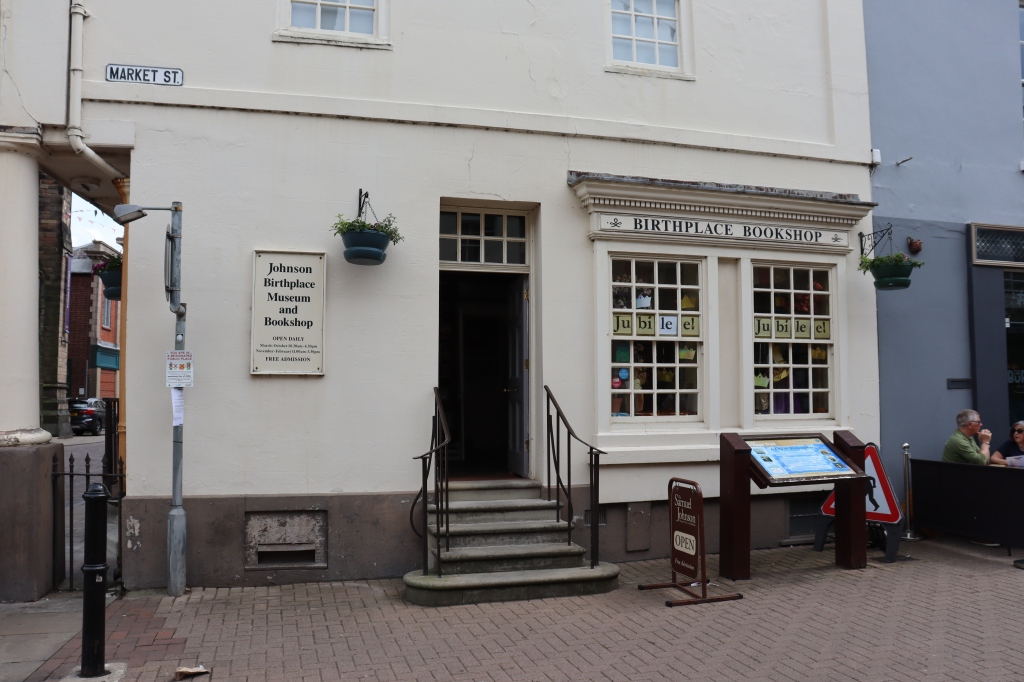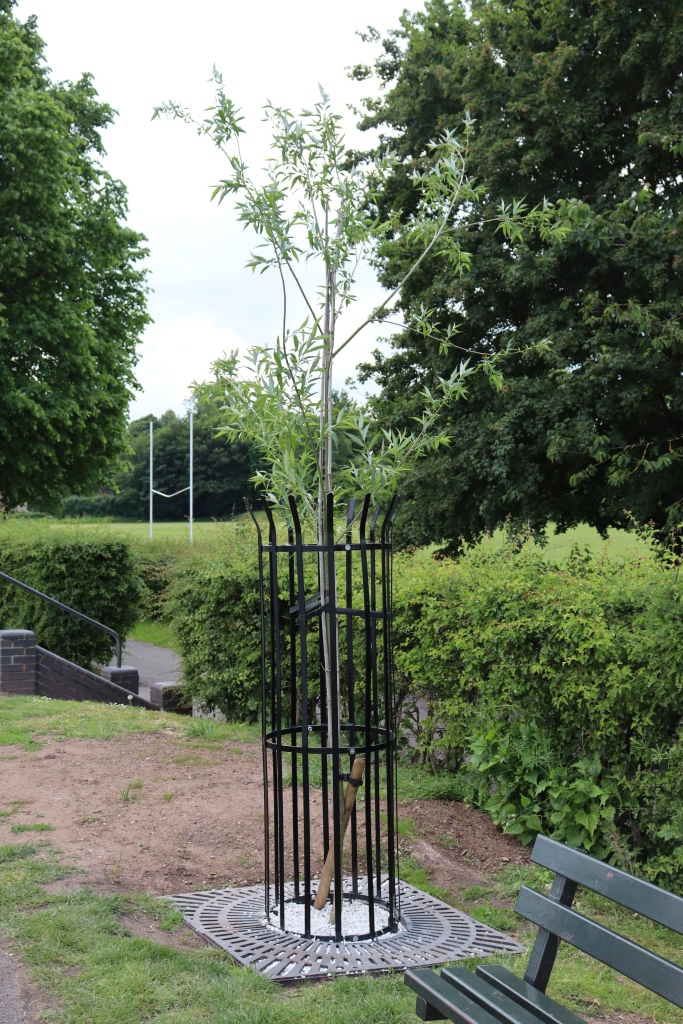Lichfield is a pleasant little midlands town. In fact, I’ve liked all the little towns I’ve visited in this part of the world. There is some grubby, late 20th Century development of course, but pre-victorian building dominates. When we visited, on a bank holiday Monday in 2022, the town was buzzing.There was nary a parking space to be found. We evenutally found one a shortish walk to the town centre, where the reason for the bustle became apparent. There was a celebration for the Queen’s birthday, or Jubilee or something and, alongside the noisy funfair in the town square, there were market stalls aplenty, selling plastic flags and royal souvenirs.

The town square itself is very pleasant, with a medieval church taking up one side with a large statue of Dr Johnson in one corner. Today, however there were candy floss and hotdog stands, hook-a-duck and dart-throwing and much else besides, all of it accompanied by the constant, interminable thumping noise and the screeching of young people. “how do you stand it?” I asked the chap at the desk in the Johnson Birthplace museum. “Oh, you get used to it” he replied, with a look that said ‘I will never get used to it.’
Michael Johnson was a bookseller. He had a shop on the corner of the market place with a comfortable little townhouse behind it. in 1709, his son Samuel was born. Samuel was a sickly child. He suffered from smallpox and then scrofula. but he had a keen interest in books. He could recite poetry from memory almost as soon as he could talk. He was sent to Lichfield Grammar school, where, despite the harsh regime, he was introduced to classical literature, discovering a love which would remain with him throughout his life. There is still a bookshop on the corner of the marketplace, attached to the Johnson Museum. Inside, you can explore rooms over five floors, each with an exhibit devoted to Johnson, his life in Lichfield and subsequent move to London. Some rooms are furnished as Johnson would have known them, some house exhibits about Johnson. There is also a facsimile of his famous dictionary.

Samuel eventually went to Pembroke college Oxford. As his father was in trade, he was considered poor. He was popular, however and made many friends despite his fearsome appearance: he was enormous with a large frame, covered in pox scars and suffering from what now is considered to Tourette’s syndrome, with regular tics and unusual mannerisms. He was a great wit and was able to entertain with words. On Coming down from Oxford, he set out to be a schoolteacher but was able to find no work. He set up a school near Lichfield but was unable to attract enough students to make it work. One of the few he did teach was a local aspiring actor named David Garrick. Johnson left the midlands and travelled to London, along with David, to try to seek a career as a journalist.

The cathedral is but a short walk from the museum. The path brought me to the South East corner, where, if you look carefully, you can see an image of Johnson carved into one of the buttresses.. It was a pleasant, sunny June afternoon and, as I walked past the soaring gothic windows and reddish brown stone of this magnificent cathedral, I was pleased to see that a pop-up bar had popped-up on the lawn outside the west front. I bought a pint and found a bench on which to enjoy it as a took in my surroundings. The lovely little half-timbered house that hides the entrance to Erasmus Darwin’s garden on one side, the magnificent cathedral with its three stately spires, reaching up into the blue Staffordshire sky on the other. stands opposite the cathedral front. Erasmus Darwin was a naturalist, philosopher and grandfather of Charles who, interestingly, came up with his own theory of evolution (he didn’t get it quite right, however, leaving it to his grandson to formulate the accepted theory)

There are two monuments to Johnson here. In addition to the one on the southeast corner, there is a bust inside, in the south transept, next to one of David Garrick, celebrating two of Lichfield’s most famous sons, and two literary greats of the Eighteenth century. Looking up at the medieval interior of the cathedral, with its soaring ceilings and intricate stone carving, it’s easy to forget that it was extensively remodelled in the Victorian era by George Gilbert Scott. He created what he believed a cathedral in the middle-ages should look like. There are some other interesting buildings in the cathedral close: on the north side, is the Bishops’ palace. The poet, Anna Seward, the so-called ‘Swan of Lichfield’, grew up in this house. Her father, Thomas, had been made canon-prebendary of the Cathedral in 1749. Luckily for her, Thomas believed in the education of women and allowed all three of his daughters (one of whom was adopted) to be educated. Anna became a highly influential poet: one of the leading figures of the Romantic movement.
I walked into the park by Stowe pool next. Johnson used to walk this way every day, and particularly admired a large willow tree that grew by the lakeside. The willow is no longer there, of course, but it is not forgotten. There is a willow sapling here that has been grown from a cutting of one that stood here previously. This is the fifth generation of willow trees that are directly descended from Johnson’s favourite tree. It’s very comforting that there are people who are still willing to keep this connection alive.